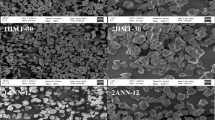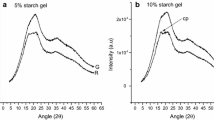Abstract
Gelatinized starches were recrystallized under hydrothermal treatment and their properties were characterized by X-ray diffractometry, solid-state 13C cross-polarization and magic-angle spinning nuclear magnetic resonance, differential scanning calorimetry, gel-permeation chromatography, high-performance anion-exchange chromatography using pulsed amperomeric detection, high-performance size-exclusion chromatography with attached multiangle laser light scattering and refractive index detectors, and digestibility analysis. Amylopectin molecules of hylon (V, VII) and water yam starch contained long side-chains with high proportion of fb1 and fb2. Under hydrothermal treatment, the double helix proportion and relative crystallinity significantly increased and reached maxima of water yam (48.7 and 28.2 %, respectively). Except water yam starch, X-ray diffraction pattern of all starches exhibited the evidence of type 2 amylose-lipid complex. Besides, under DSC measurement, potato and hylon starches showed the endotherm of amylose-amylose interaction. The hydrothermal treatment caused the recrystallization resulting in the decrease of RDS, especially in case of hylon and water yam starch. HTT water yam contained highest SDS (48.3 %) and HTT hylon VII contained highest RS (44.5 %). The relationship between structure and digestibility was observed, in which, high amylose content and specific structures of amylopectin molecule were necessary for the production of RS and/or SDS of hydrothermally treated starches.



Similar content being viewed by others
References
American association of cereal chemists (2000) Approved methods of the AACC (10th ed.), St.Paul. MN: The American association of cereal chemists
Berry CS (1986) Resistant starch - formation and measurement of starch that survives exhaustive digestion with amylolytic enzymes during the determination of dietary fiber. J Cereal Sci 4(4):301–314
Biliaderis CG, Galloway G (1989) Crystallization behavior of amylose-V complexes - structure property relationships. Carbohyd Res 189:31–48
Bjorck I, Eliasson AC, Drews A, Gudmundsson M, Karlsson R (1990) Some nutritional properties of starch and dietary fiber in barley genotypes containing different levels of amylose. Cereal Chem 67(4):327–333
Bogracheva TY, Wang YL, Hedley CL (2001) The effect of water content on the ordered/disordered structures in starches. Biopolymers 58(3):247–259
Brumovsky JO, Thompson DB (2001) Production of boiling-stable granular resistant starch by partial acid hydrolysis and hydrothermal treatments of high-amylose maize starch. Cereal Chem 78(6):680–689
Chung HJ, Liu Q (2009) Impact of molecular structure of amylopectin and amylose on amylose chain association during cooling. Carbohyd Polym 77(4):807–815
Colonna P, Barry JL, Cloarec D, Bornet F, Gouilloud S, Galmiche JP (1990) Enzymic susceptibility of starch from pasta. J Cereal Sci 11(1):59–70
Cooke D, Gidley MJ (1992) Loss of crystalline and molecular order during starch gelatinization - origin of the enthalpic transition. Carbohyd Res 227:103–112
Dubois M, Gilles KA, Hamilton JK, Rebers PA, Smith F (1956) Colorimetric method for determination of sugars and related substances. Anal Chem 28(3):350–356
Eerlingen RC, Delcour JA (1995) Formation, analysis, structure and properties of type-III enzyme resistant starch. J Cereal Sci 22(2):129–138
Eerlingen RC, Deceuninck M, Delcour JA (1993) Enzyme-resistant starch. 2. Influence of amylose chain-length on resistant starch formation. Cereal Chem 70(3):345–350
Eliasson A-C & Gudmundsson M (2006) Starch: physicochemical and functional aspects. In: Eliasson, A.-C (ed) Carbohydrates in food, 2nd edn. Boca Raton, FL, CRC Press, pp: 391–469
Franco CML, Wong KS, Yoo SH, Jane JL (2002) Structural and functional characteristics of selected soft wheat starches. Cereal Chem 79(2):243–248
Gidley MJ, Bociek SM (1985) Molecular-organization in starches - a C-13 CP MAS NMR-study. J Am Chem Soc 107(24):7040–7044
Gidley MJ, Bulpin PV (1987) Crystallization of maltooligosaccharides as models of the crystalline forms of starch - minimum chain-length requirement for the formation of double helices. Carbohyd Res 161(2):291–300
Gidley MJ (1987) Factors affecting the crystalline type (Ac) of native starches and model compounds - a rationalization of observed effects in terms of polymorphic structures. Carbohyd Res 161(2):301–304
Guraya HS, James C, Champagne ET (2001) Effect of enzyme concentration and storage temperature on the formation of slowly digestible starch from cooked debranched rice starch. Starch-Starke 53(3–4):131–139
Han JA, Lim ST (2004) Structural changes of corn starches by heating and stirring in DMSO measured by SEC-MALLS-RI system. Carbohyd Polym 55(3):265–272
Hanashiro I, Abe J, Hizukuri S (1996) A periodic distribution of the chain length of amylopectin as revealed by high-performance anion-exchange chromatography. Carbohyd Res 283:151–159
Higgins J, Donahoo W, Higbee D, Bing K, Brown I & Bessesen D (2005) Chronic consumption of resistant starch promotes postprandial lipid oxidation. Obes Res 13:A4-A4
Hoover R, Hadziyev D (1981) Characterization of potato starch and its monoglyceride complexes. Starch-Starke 33(9):290–300
Jane JL, Chen JF (1992) Effect of amylose molecular-size and amylopectin branch chain-length on paste properties of starch. Cereal Chem 69(1):60–65
Jane JL, Wong KS, McPherson AE (1997) Branch-structure difference in starches of a- and B-type x-ray patterns revealed by their naegeli dextrins. Carbohyd Res 300(3):219–227
Jay-lin Jane (2009) Starch chemistry and technology. In: BeMiller J & Whistler R (eds) Structural features of starch granules II, 3rd edn Elservier, NewJork, pp 1993–1236
Jenkins DJA, Kendall CWC, Marchie A, Augustin LSA (2004) The glycaemic index: an overview of its possible role in the prevention and treatment of chronic disease. Int J Clin Pract 58:3–7
Jiang HX, Campbell M, Blanco M & Jane JL (2010) Characterization of maize amylose-extender (ae) mutant starches: part II. Structures and properties of starch residues remaining after enzymatic hydrolysis at boiling-water temperature. Carbohyd Polym 80(1):1–12
Kaletunç G & Breslauer KJ (2003) Calorimetry of pre- and postextruded cereal flours. In: Kaletunç G & Breslauer KJ (eds) Characterization of cereals and flours. properties, analysis, and applications, 1st edn, Marcel Dekker, NewYork, pp 1–35
Khanh Son Trinh, Chang Joo Lee, Seung Jun Choi & Tae Wha Moon (2012) Hydrothermal treatment of water yam starch in a Non-granular state: slowly digestible starch content and structural characteristics. J Food Sci 00(0): C1-C9
Lehmann U, Robin F (2007) Slowly digestible starch - its structure and health implications: a review. Trends Food Sci Tech 18(7):346–355
Levine H & Slade L (1989) Influence of glassy and rubbery states on the thermal, mechanical, and structural properties of doughs and baked products. In: Fairidi, H & Faubion, JM (eds) Dough rheology and baked product texture, 1st edn, Springer, New York, pp 157–300.
Lopez-Rubio A, Flanagan BM, Gilbert EP, Gidley MJ (2008) A novel approach for calculating starch crystallinity and its correlation with double helix content: a combined XRD and NMR study. Biopolymers 89(9):761–768
Miller GL (1972) Use of DNS reagent for the determination of glucose. Anal Chem 31:426–428
Morrison WR, Laignelet B (1983) An improved colorimetric procedure for determining apparent and total amylose in cereal and other starches. J Cereal Sci 1:9–20
Nara S, Komiya T (1983) Studies on the relationship between water-saturated state and crystallinity by the diffraction method for moistened potato starch. Starch/Starke 35:407–410
Nugent AP (2005) Health properties of resistant starch. British Nutrition Foundation 30:27–54
Park EY, Baik BK, Lim ST (2009) Influences of temperature-cycled storage on retrogradation and in vitro digestibility of waxy maize starch gel. J Cereal Sci 50(1):43–48
Park JT, Rollings JE (1994) Effects of substrate branching characteristics on kinetics of enzymatic depolymerization of mixed linear and branched polysaccharides. 1. Amylose/amylopectin alpha-amylolysis. Biotechnol Bioeng 44(7):792–800
Ring SG, Colonna P, Ianson KJ, Kalichevsky MT, Miles MJ, Morris VJ, Orford PD (1987) The gelation and crystallization of amylopectin. Carbohyd Res 162(2):277–293
Robin JP, Mercier C, Charbonn R, Guilbot A (1974) Lintnerized starches gel-filtration and enzymatic studies of insoluble residues from prolonged acid treatment of potato starch. Cereal Chem 51(3):389–406
Rodgers JL, Nicewander WA (1988) Thirteen ways to look at the correlation coefficient. Am Stat 42:59–66
Sajilata MG, Singhal RS & Kulkarni PR (2006) Resistant starch - a review. Compr Rev Food Sci F 5(1):1–17
Shin SI, Chang Joo Lee b, Kim MJ, Choi SJ, Choi HJ, Kim Y, Moon TW (2009) Structural characteristics of low-glycemic response rice starch produced by citric acid treatment. Carbohydr Polym 78:588–595
Srichuwong S, Sunarti TC, Mishima T, Isono N, Hisamatsu M (2005) Starches from different botanical sources I: contribution of amylopectin fine structure to thermal properties and enzyme digestibility. Carbohyd Polym 60(4):529–538
Stevenson DG, Jane JL, Inglett GE (2007) Structures and physicochemical properties of starch from immature seeds of soybean varieties (Glycine max (L.) merr.) exhibiting normal, low-linolenic or low-saturated fatty acid oil profiles at maturity. Carbohyd Polym 70(2):149–159
Vasanthan T, Bhatty RS (1996) Physicochemical properties of small- and large-granule starches of waxy, regular, and high-amylose barleys. Cereal Chem 73(2):199–207
Wang YJ, White P, Pollak L, Jane J (1993) Characterization of starch structures of 17 maize endosperm mutant genotypes with Oh43 inbred line background. Cereal Chem 70(2):171–179
Whistle RL & BeMiller JN (1997) Polysaccharides. In: BeMiller JN (ed) Carbohydrate chemistry for food scientists, 1st edn, AACC International, pp:63–89
You SG, Lim ST (2000) Molecular characterization of corn starch using an aqueous HPSEC-MALLS-RI system under various dissolution and analytical conditions. Cereal Chem 77(3):303–308
Zhang GY, Hamaker BR (2009) Slowly digestible starch: concept, mechanism, and proposed extended glycemic index. Crit Rev Food Sci 49(10):852–867
Zhang GY, Sofyan M, Hamaker BR (2008) Slowly digestible state of starch: mechanism of slow digestion property of gelatinized maize starch. J Agr Food Chem 56(12):4695–4702
Zobel HF (1988) Starch crystal transformations and their industrial importance. Starch-Starke 40(1):1–7
Zobel HF, French AD & Hinkle ME (1967) X-Ray Diffraction of oriented amylose fibers 0.2. structure of V amyloses. Biopolymers 5(9):837–845.
Acknowledgments
This work was supported by Ho Chi Minh City University of Technical Education.
Author information
Authors and Affiliations
Corresponding author
Rights and permissions
About this article
Cite this article
Trinh, K.S. Recrystallization of starches by hydrothermal treatment: digestibility, structural, and physicochemical properties. J Food Sci Technol 52, 7640–7654 (2015). https://doi.org/10.1007/s13197-015-1945-6
Revised:
Accepted:
Published:
Issue Date:
DOI: https://doi.org/10.1007/s13197-015-1945-6




